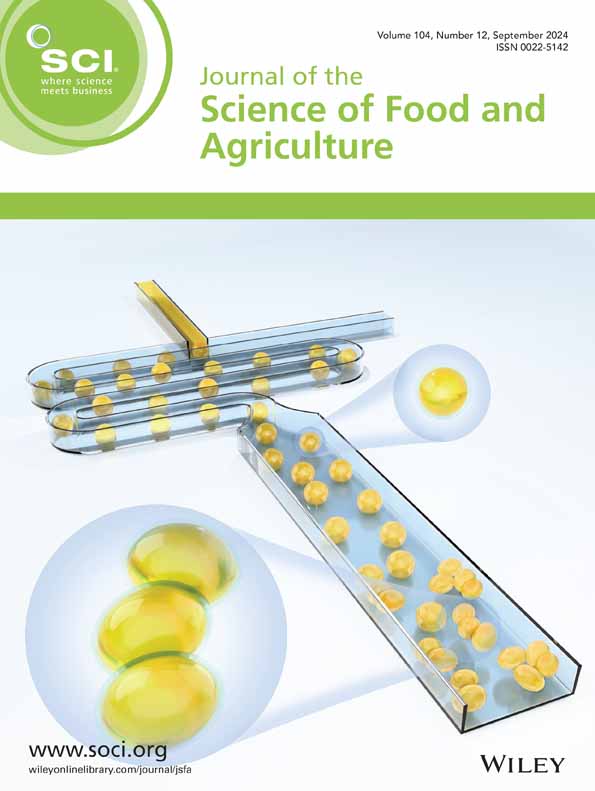Nguyễn Hoàng Ly, Tan Phat Dao, Lalitha Gnanasekaran, Yasser Vasseghian, Sang-Woo Joo
求助PDF
{"title":"金属有机骨架/壳聚糖平台催化降解食物垃圾及微藻培养研究。","authors":"Nguyễn Hoàng Ly, Tan Phat Dao, Lalitha Gnanasekaran, Yasser Vasseghian, Sang-Woo Joo","doi":"10.1002/jsfa.14178","DOIUrl":null,"url":null,"abstract":"<p>Innovative technologies can convert food waste into an economic opportunity. A potential approach to be discussed in this review article is combining microalgae cultivation with catalytic metal–organic frameworks (MOFs) and chitosan platforms. Due to the high availability of nutrients and organic content, food waste can be classified as one of the most promising feedstocks for bioprocessing. MOFs are known for high surface area, modulable porosity, and the property to adsorb molecules thus being recently used as efficient catalysts in the related valorization of food wastes. Chitosan is a natural polyelectrolyte copolymer exhibiting excellent biological properties, making it an attractive platform to fabricate diverse biomedical materials. The most recent research proposes another use of food waste – as a resource in producing high-value materials. In particular, studies concentrate on designing chitosan and molecular porous MOF platforms with microalgae as applications for food waste valorization. One important approach would be to tailor the synthetic properties and functionalities of chitosan-based MOFs allowing them to be efficiently utilized. The facile catalytic chitosan-based MOF platform strategy established herein provides a new way to combine with microalgae cultivation for converting organic waste into desirable biomass. This review delivers a future-oriented idea regarding how chitosan-based MOF and microalgae can be co-participated in food waste harvesting followed by perspective challenges and future. © 2025 Society of Chemical Industry.</p>","PeriodicalId":17725,"journal":{"name":"Journal of the Science of Food and Agriculture","volume":"105 9","pages":"4695-4705"},"PeriodicalIF":3.5000,"publicationDate":"2025-02-11","publicationTypes":"Journal Article","fieldsOfStudy":null,"isOpenAccess":false,"openAccessPdf":"","citationCount":"0","resultStr":"{\"title\":\"Valorization of food wastes by catalytic metal–organic frameworks/chitosan platform and microalgae cultivation\",\"authors\":\"Nguyễn Hoàng Ly, Tan Phat Dao, Lalitha Gnanasekaran, Yasser Vasseghian, Sang-Woo Joo\",\"doi\":\"10.1002/jsfa.14178\",\"DOIUrl\":null,\"url\":null,\"abstract\":\"<p>Innovative technologies can convert food waste into an economic opportunity. A potential approach to be discussed in this review article is combining microalgae cultivation with catalytic metal–organic frameworks (MOFs) and chitosan platforms. Due to the high availability of nutrients and organic content, food waste can be classified as one of the most promising feedstocks for bioprocessing. MOFs are known for high surface area, modulable porosity, and the property to adsorb molecules thus being recently used as efficient catalysts in the related valorization of food wastes. Chitosan is a natural polyelectrolyte copolymer exhibiting excellent biological properties, making it an attractive platform to fabricate diverse biomedical materials. The most recent research proposes another use of food waste – as a resource in producing high-value materials. In particular, studies concentrate on designing chitosan and molecular porous MOF platforms with microalgae as applications for food waste valorization. One important approach would be to tailor the synthetic properties and functionalities of chitosan-based MOFs allowing them to be efficiently utilized. The facile catalytic chitosan-based MOF platform strategy established herein provides a new way to combine with microalgae cultivation for converting organic waste into desirable biomass. This review delivers a future-oriented idea regarding how chitosan-based MOF and microalgae can be co-participated in food waste harvesting followed by perspective challenges and future. © 2025 Society of Chemical Industry.</p>\",\"PeriodicalId\":17725,\"journal\":{\"name\":\"Journal of the Science of Food and Agriculture\",\"volume\":\"105 9\",\"pages\":\"4695-4705\"},\"PeriodicalIF\":3.5000,\"publicationDate\":\"2025-02-11\",\"publicationTypes\":\"Journal Article\",\"fieldsOfStudy\":null,\"isOpenAccess\":false,\"openAccessPdf\":\"\",\"citationCount\":\"0\",\"resultStr\":null,\"platform\":\"Semanticscholar\",\"paperid\":null,\"PeriodicalName\":\"Journal of the Science of Food and Agriculture\",\"FirstCategoryId\":\"97\",\"ListUrlMain\":\"https://onlinelibrary.wiley.com/doi/10.1002/jsfa.14178\",\"RegionNum\":2,\"RegionCategory\":\"农林科学\",\"ArticlePicture\":[],\"TitleCN\":null,\"AbstractTextCN\":null,\"PMCID\":null,\"EPubDate\":\"\",\"PubModel\":\"\",\"JCR\":\"Q1\",\"JCRName\":\"AGRICULTURE, MULTIDISCIPLINARY\",\"Score\":null,\"Total\":0}","platform":"Semanticscholar","paperid":null,"PeriodicalName":"Journal of the Science of Food and Agriculture","FirstCategoryId":"97","ListUrlMain":"https://onlinelibrary.wiley.com/doi/10.1002/jsfa.14178","RegionNum":2,"RegionCategory":"农林科学","ArticlePicture":[],"TitleCN":null,"AbstractTextCN":null,"PMCID":null,"EPubDate":"","PubModel":"","JCR":"Q1","JCRName":"AGRICULTURE, MULTIDISCIPLINARY","Score":null,"Total":0}
引用次数: 0
引用
批量引用

 求助内容:
求助内容: 应助结果提醒方式:
应助结果提醒方式:


